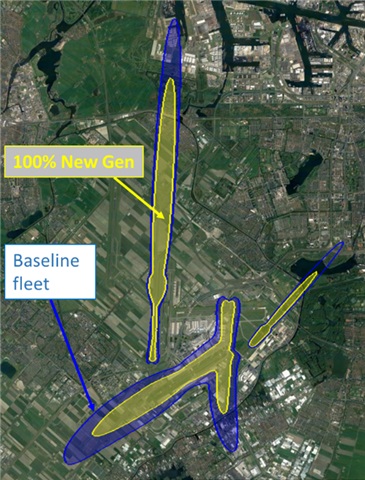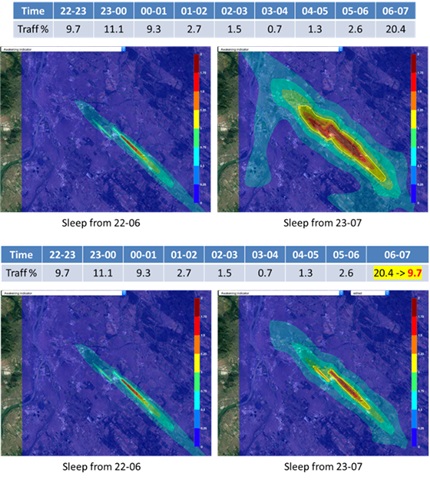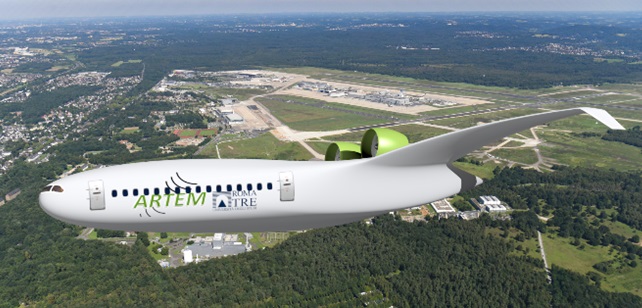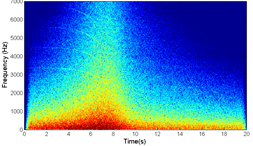ANIMA: Aviation Noise Impact Management through Novel Approaches
By Graeme Heyes, Laurent Leylekian, Alexandra Covrig, Roalt Aalmoes, Ingrid LeGriffon, and Eugene Kors

The majority of noise research projects in aviation have taken a technocentric approach by focusing on reducing noise at source—that is, through quieter aircraft and engine design. Such efforts are important and have been an incredible success, with modern aircraft significantly quieter than they were just a few decades ago. Noise does, however, remain a prominent challenge because of the significant health burden that noise causes to local airport communities.
This is reflected by common objections to building new airport infrastructure and the number of complaints at most airports that do not reflect the reductions in noise from individual aircraft. Research is therefore needed not only to make individual aircraft quieter but also to understand the complexities of noise impact and the role that industry can play in managing this impact. Outcomes of the ANIMA project may help authorities and airports to initiate a more appropriate approach to the issue for post-COVID traffic resumption.
What Is ANIMA?
ANIMA has taken a different approach from other research programs by acknowledging that reducing noise annoyance and other health impacts associated with aviation noise goes beyond the engineering accomplishments of aircraft design alone. Rather, ANIMA takes the perspective that the communities living around airports are the main stakeholders of the noise challenge, as they are directly impacted by this problem. Therefore, any project aiming at managing the impact of noise must put the communities at the center of its action. Put simply, noise management responses have to be technically viable and feasible (areas in which the industry has done incredibly well) but also desirable to community stakeholders, authorities, and industry.
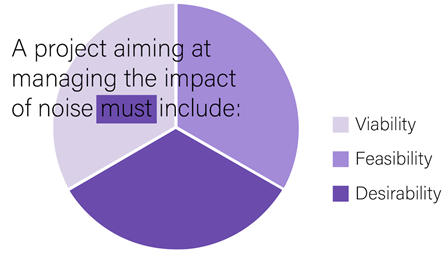
Accordingly, ANIMA brings together aircraft engineers and specialists in urban geography, psychologists, and sociologists as well as with experts on aviation regulation, policy, and practice to take a holistic view of the noise management challenge. Together, these experts set and evaluate scenarios and engage in dialogue with airports and noise-affected communities in order to capture how interventions to mitigate aviation noise are implemented—and how far these steps are effective in reducing annoyance or in improving the quality of life (QoL) of nearby residents. That is a genuine interdisciplinary and unique approach.
How Is ANIMA Organized?
ANIMA research and impact is driven through five work packages, as outlined below.
Review and Assessment of Noise Impact and Related Management Practices
This work package has sought to review the current ways airports are managing noise regulations and annoyance and the scientific literature surrounding annoyance and health impacts associated with noise. Notably, this work conducted a series of case studies of airport management activity across Europe and, in so doing, highlighted industry responses to policy, through practice, as well as highlighting future research needs.
The work also reviewed the use of metrics and tools and assessed their relevance to quantify environmental performance characteristics and how this can be used to inform trade-offs between environmental attributes (e.g., noise vs. carbon emissions). It examined the extent to which airports are under pressure to deliver on a suite of potentially competing environment agendas. Additionally, a review took place regarding the range of noise metrics and modeling tools used to monitor and evaluate performance of noise management interventions and the how communicate these and use them to inform a wider noise management strategy.
Researchers also investigated the relevance of experience in other transport and industrial sectors affected by noise in terms of the means of measuring, modeling, and communicating noise exposure. The collective findings from this research were then put into practice to inform on airport noise management interventions in real case study settings.
Notable highlights from this work package include the fact that there is no single best-practice response to noise management. Rather, “effective practice” can be developed and delivered by airports through repeatable and rigorous processes based on targeted outcomes and evaluation that includes consideration of qualitative factors—including resident perspectives of noise. Effective long-term strategic thinking of the noise problem and flexible step processes are advocated to help airports manage noise effectively. For instance, airports could borrow concepts from approaches used in other sectors to design services that aim to solve business problems, such as “Design-Thinking.”
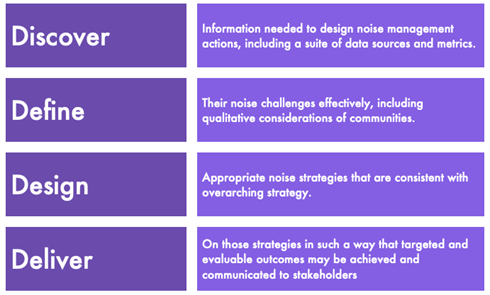
Additionally, ANIMA has highlighted annoyance and sleep disturbance as factors contributing to key health impacts, while trends in the exposure-response relationship suggest an increasing sensitivity to noise (increase in the percentage of highly annoyed residents with respect to a given exposure level). There is a need for more standardization in the assessment of health outcomes. Moreover, statistical analysis indicates that the noise level correlates to only about a third of annoyance. Hence, aggregated noise descriptors (e.g., Leq) are not always the best way to describe annoyance or other human impacts. Moreover, addressing nonacoustic factors directly can play a key role in the management of noise health impacts, suggesting a need for effective communication and engagement in both the design and delivery of noise management interventions, as defined by the ICAO Balanced Approach, but as noise management actions in their own right.
Together, this work found that noise management is a deeply complex issue, the effective management of which requires deep consideration and long-term strategic thinking regarding a range of factors, both quantitative and qualitative in nature, including communication and engagement that can lead to what are perceived as fair outcomes by communities. Noise management needs to design robust noise management actions that can deliver targeted outcomes (not necessarily represented through noise metrics) and where progress toward such outcomes can be evaluated. This includes the necessity to understand the noise environment around airports in terms of both quantitative noise data and the perspectives of those who are the ultimate recipients of noise management interventions: residents.
Reducing Noise Impact and Improving Quality of Life by Addressing Annoyance
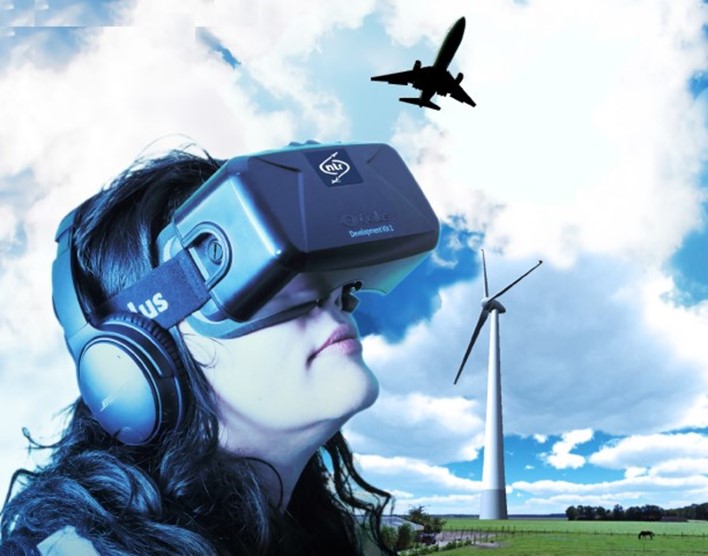
This work package investigates the potential to reduce noise impact and improve the QoL by focusing on noise annoyance. First, relevant factors that can influence the QoL of residents living near an airport were identified, to produce an ANIMA set of QoL indicators. Of course, some factors affecting the QoL are controllable by airports or authorities (e.g., insulation plans) whereas others are not (e.g., personal incomes).
These indicators will help airports to develop QoL strategies, including potential activities, intended outcomes, and evaluation protocols, by empowering them to
- determine which dimensions and topics they are already addressing;
- understand how specific interventions across these indicators are being evaluated and whether a link to QoL outcomes can be made; and
- identify areas that are not being addressed that the airport could/should be engaging with. These “gaps” could form the basis of discussions with local communities as to what is the most useful/beneficial foci for airport interventions.
Additionally, this part of the project has sought new insights on the reduction of annoyance and sleep disturbance by understanding the roles of effective communication and engagement in lowering annoyance, by working with communities to understand communication and engagement needs and perspectives, and the potential role in designing and implementing noise management interventions. This work package also saw the development of awakenings indicator and protection regime for night noise, as well as the creation and use of auralization and visualization tools that can be used to engage airport communities. This used a novel application of a virtual reality simulator as a way to understand resident perspectives on noise and airport operations.
Finally, the work package investigates novel and cost-effective solutions for land-use planning in relation to people’s perception of environmental sound near airports. This work takes a unique approach by using a mobile application to collect data around Heathrow and Ljubljana Airport. Together with a carefully crafted social media study, data on property value, and movement of people throughout the day, this will establish more evidence on the relationship between land-use planning, noise perception, and QoL and help airports to better manage this dynamic. The outcomes of all studies will be tested later in intervention studies and/or integrated into the ANIMA Noise Platform.
Many results from this work package are already published on the ANIMA website and have been presented at scientific conferences. In general, all ANIMA results are available on the Zenodo platforms referred to by the OpenAire system or will become available during 2021. Outcomes from the studies also will be translated toward best practices and transposed to other work packages, including intervention case studies taking place in the work package presented above on Review and Assessment of Noise Impact.
Toolsets Development and Scenarios Assessment
Work Package 3 serves as the technical support of ANIMA. It provides a Virtual Community Tool designed to empower local stakeholders to experience, predict, and evaluate the noise impact of different air traffic scenarios—and thus empower airports to understand potential impacts on annoyance. In so doing, the tool is designed to give end users the ability to calculate noise maps for a virtual aircraft fleet over a given period of time. Importantly, the tool also utilizes annoyance-related metrics and interdependencies with emissions.
A public version of this Noise Management Toolset consisting of a predesigned generic virtual airport will be made available on the ANIMA Noise Platform to illustrate the underlying concepts to the public. A more interactive version, with fully changeable parameters and real-world airports, will also be produced for use by airport managers and authorities.
The tool is also designed to help guide and develop the European Aviation Noise Research Roadmap. This is achieved by generating scenarios with existing and future aircraft designs and evaluating the effect of changes in noise impact produced by variations in flight trajectories, noise mitigation solutions, or other improvements. The tool is dynamic enough to account for the impact of technological innovations—for example, impacts on noise contours when replacing current fleets by new generation aircraft types (NEO, MAX families) or new concepts like blended wing body aircraft. Night flight schedules can also be adapted and their impact evaluated via an awakening index. This tool has shown that shifting flights from early morning hours to late evening hours can reduce the number of additional awakenings due to flight traffic.
Right: Effect of flight night hour on number of additional awakenings
The Virtual Community Tool also makes an important contribution toward effective dialogues between different stakeholder groups by providing a range of audiovisual demonstrations based on different parameters, through a range of scenarios that can be experienced through the virtual reality device described previously. The tool therefore can play a valuable role in demonstrating the differences between different scenarios—for instance, different flight tracks or new aircraft concepts.
Right: Time-level history at approach condition
Road Mapping
ANIMA also includes a comprehensive road-mapping activity dedicated to the definition and updating of a common European strategic research road map for aviation noise reduction. Such road maps compile all key aspects related to noise mitigation solutions, the assessment of noise effects on populations, and community engagement. These road maps have been created for many different aspects, such as those listed in the image here.
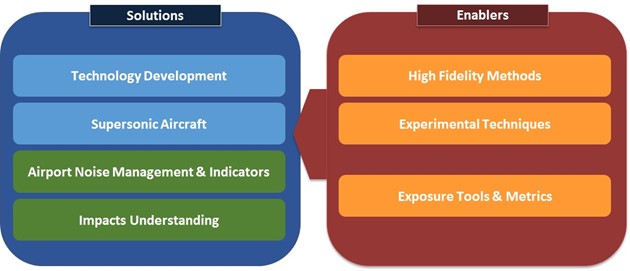
This work complements the recent generation of road maps for Drones, UAVs, and other air transport trends and includes priority areas that require further research, development, and exploitation for their potential to be fully realized. This includes the use of milestones as a pathway toward implementation. By regularly updating this vision and sharing the road maps with the stakeholder community (via the ANIMA Noise Platform), this aspect of the project will help to ensure that the results, not only for ANIMA but also for air transport in Europe as a whole, are able to actively inform on the future development of European airspace.
Dissemination and Impact
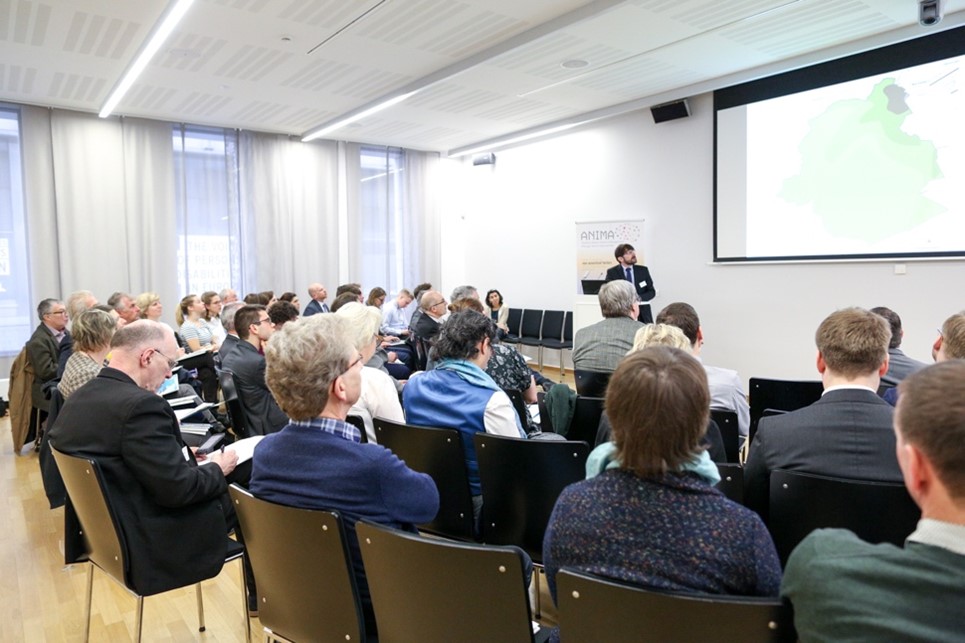
ANIMA seeks to improve the lives of people directly affected by aviation noise around Europe’s 45 major airports. Noise management in airport areas can only be successful when all stakeholders engage in open dialogue, including those who are creating the noise as well as those perceiving it. Therefore, a vital part of the project is connecting with local communities to ensure meaningful, consistent, and comprehensive community engagement. Several events have been organized with local communities (e.g., Gava, Spain and Kranj, Slovenia), encouraging them to express their opinion and to get involved in decision-making. These events aim to inspire all stakeholders to work collaboratively toward a common noise policy that benefits all parties.
To maximize the impact of the project outcomes, ANIMA is also launching a unique “Noise Platform” that gathers the tools and knowledge developed in the project and makes them available to stakeholders by facilitating dissemination toward end users and accelerating take-up of results. The ANIMA Platform will be continuously updated with information from all work packages—examples of operations, land-use planning, and best-practice cases, mobile application, and QoL indicators (Work Package 2); noise management toolsets and Virtual Community Tool (Work Package 3); aviation noise research road map (Work Package 4)—and a range of scientific publications and ANIMA deliverable reports. To ensure that the platform is effective, it was built on three primary pillars:
- Understanding Airport Noise and Its Underlying Concepts
Throughout the years of the project, and mainly during the evaluation of interventions for managing airport noise, ANIMA has noticed that there are still many knowledge gaps among relevant stakeholders. For instance, it seems still unclear which are the actual relevant stakeholders for managing airport noise or how to quantify a measure in both acoustical and nonacoustical terms, or even which is the appropriate legislative framework for managing interventions. - Best-Practice Cases
ANIMA platform will include best-practice cases, generated from a comprehensive study of 14 interventions in 13 different airports, for the evaluation of noise management practices. These cases captured experience from different airports on specific interventions, and their role is to facilitate a better understanding of processes needed for the implementation of such measures. - ANIMA Methodology
The research carried out in the ANIMA project showed that more effective outcomes can be achieved by supporting airport managers in community engagement, helping the process of prioritization, and providing information and tools on potential solutions that can then be discussed with stakeholders.
COVID-19 and Next Steps
It is impossible to deny the impact that COVID-19 has had on ANIMA. Air traffic has almost ground to a standstill, and this has made several aspects of our research difficult, requiring the ingenuity of our researchers to find innovative solutions for continuing their work.
This is particularly the case for research concerning airport residents, with whom direct face-to-face interaction toward the end of the project has been impossible. Moreover, canvassing communities about their perspectives of noise during the unusual and quiet period has been a major stumbling block, as the world we live in today does not represent what it once was and what we hope it will soon be again.
However, as a result of the efforts of our team, the project is working toward completion in 2021, and the ANIMA Noise Platform was officially launched in January 2021. The platform is under continuous development and more content will be made available over time. For instance, it will soon be populated with best-practice case studies from airports around Europe. This platform will ensure long lasting impact from ANIMA research and will inform on noise management practice across the European Union for decades to come and help European airspace to truly build a quieter future.
As we move toward defeating COVID-19, our aspiration is that ANIMA research will help avoid the onset of previously experienced noise issues and help enhance the lives of millions of European citizens.
